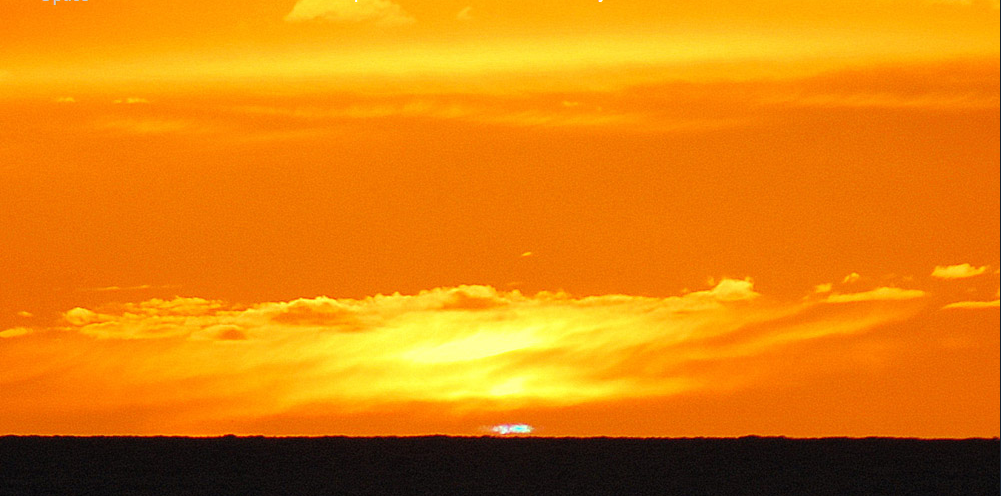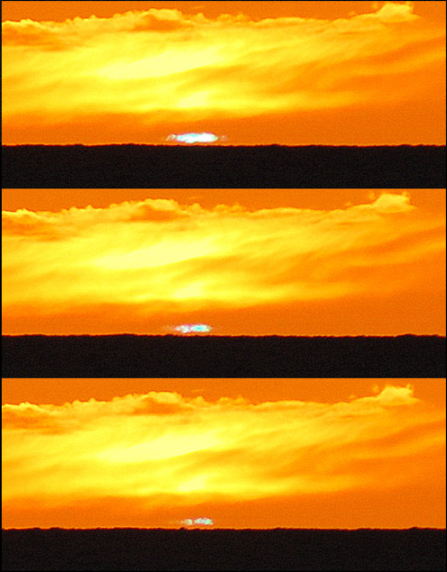OPOD - Wales Blue Flash
OPOD - Wales Blue Flash: A Rare Atmospheric Phenomenon
Witnessing rare atmospheric phenomena can be an awe-inspiring experience. One such phenomenon is the blue flash, which was beautifully captured by photographer Mark Evans during a sunset over Swansea Bay and the Bristol Channel in South Wales. The blue flash, typically associated with the green flash, occurs as the last fraction of the sun sinks below the horizon. In this article, we will delve deeper into the science behind this captivating event and explore its characteristics.
As the sun approached the horizon on that particular evening, Mark Evans had a hunch that a green flash might occur. With his Nikon D60 equipped with a 300mm lens, he patiently waited, resisting the temptation to directly gaze at the sun. His intuition proved correct when a top-knot formed and detached from the main disc of the sun. However, instead of the anticipated green hue, the flash appeared distinctly blue. This unexpected sight momentarily stunned Evans before he quickly regained his composure and managed to capture three stunning photographs.
The blue flash is classified as an inferior-mirage type of phenomenon caused by the refraction of light through a layer of warmer air beneath cooler air. This classical flash occurs just above the horizon as the last sliver of the sun disappears. The presence of a distorted sunset and a choppy horizon are warning signs indicating the mirage boundary where this atmospheric phenomenon takes place.
What sets the blue flash apart from its already rare counterpart, the green flash, is its infrequency. While green flashes are relatively uncommon, spotting a blue flash is even rarer. The occurrence of a blue flash signifies strong temperature gradients within the atmosphere. These variations in temperature create unique conditions for light refraction, resulting in the distinctive blue coloration.
To better understand this mesmerizing event, it is important to explore the underlying science. When sunlight passes through Earth's atmosphere, it undergoes scattering, refraction, and dispersion. Refraction refers to the bending of light as it passes through different mediums, such as air layers with varying temperatures. The amount of bending depends on the refractive index of the medium, which is influenced by its density. In the case of the blue flash, the refraction of light through the temperature gradient causes a deviation in the path of the light rays, leading to the perception of a blue hue.
The rarity of the blue flash can be attributed to several factors. Firstly, the atmospheric conditions must be conducive to the formation of temperature inversions, where a layer of warmer air exists beneath cooler air. This creates the necessary temperature gradient for the refraction to occur. Additionally, clear and stable atmospheric conditions are essential for optimal visibility of the blue flash. Any atmospheric disturbances, such as haze or clouds, can obstruct or diminish the visibility of this captivating phenomenon.
In conclusion, witnessing a blue flash during a sunset is a remarkable event that highlights the intricate interplay between light and atmospheric conditions. The distinct blue hue, resulting from the refraction of light through a layer of warmer air beneath cooler air, sets the blue flash apart from its green counterpart. Its rarity adds to its allure, making it a truly special occurrence for those fortunate enough to witness it. So, keep your eyes peeled during sunsets and perhaps you might be one of the lucky few to catch a glimpse of this enchanting atmospheric phenomenon.

Blue Flash ~Images by Mark Evans.
"After a day at Kenfig beach, near Porthcawl, S. Wales, I decided to stay for the sunset over Swansea Bay and the Bristol Channel.
As the sun approached the horizon I had a feeling that a green flash was a distinct possibility, so I fitted the 300mm lens to my Nikon D60 and waited, trying all the while to resist the temptation to look at the sun. Eventually, as the last fraction of the sun was sinking to the horizon, I watched through the viewfinder and was delighted when as expected, a top-knot formed and detached from the main disc of the sun, but instead of the green I'd expected, it seemed to be distinctly blue. I was so taken aback, that for a moment I forgot to take any photos, but then snapped out of it and managed to get these three shots. " ©Mark Evans, shown with permission.
The flash is likely an inferior-mirage type produced by refraction through a layer of warmer air beneath cooler. This is the classical flash occurring just above the horizon as the last sliver of sun disappears.
Warning signs are a distorted sunset and a choppy horizon that is actually the mirage boundary.
A blue flash signals strong temperature gradients and is a rarer sight than the already rare green flash.


Note: this article has been automatically converted from the old site and may not appear as intended. You can find the original article here.
Reference Atmospheric Optics
If you use any of the definitions, information, or data presented on Atmospheric Optics, please copy the link or reference below to properly credit us as the reference source. Thank you!
-
<a href="https://atoptics.co.uk/blog/opod-wales-blue-flash/">OPOD - Wales Blue Flash</a>
-
"OPOD - Wales Blue Flash". Atmospheric Optics. Accessed on July 27, 2024. https://atoptics.co.uk/blog/opod-wales-blue-flash/.
-
"OPOD - Wales Blue Flash". Atmospheric Optics, https://atoptics.co.uk/blog/opod-wales-blue-flash/. Accessed 27 July, 2024
-
OPOD - Wales Blue Flash. Atmospheric Optics. Retrieved from https://atoptics.co.uk/blog/opod-wales-blue-flash/.